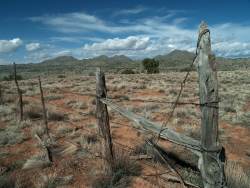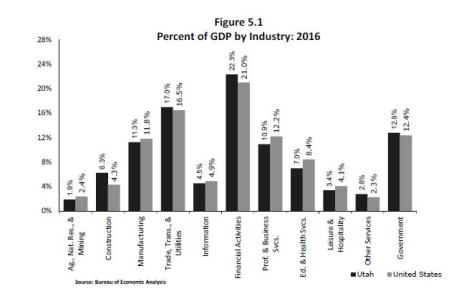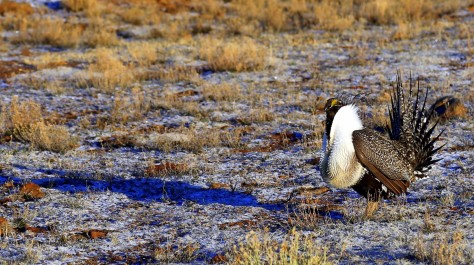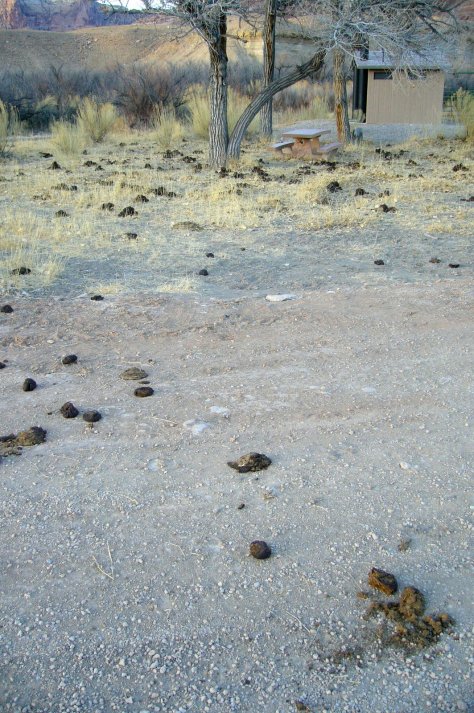Put an end to public land livestock grazing
Utah is 90 percent urban. Much of the West is the same. Yet it is run politically as though it is mostly rural and agricultural. Most Utahns live along the urban Wasatch Front from Ogden to Provo. The Wasatch Mountains bordering the Front are in the U.S. Wasatch National Forest. Even though the Wasatch forests receive traffic like a major national park with millions of visitors per year, these forests are in the best shape of any of the national forests in the state. The reason? No cows. No sheep. No barbed wire. The public would never stand for it.
The rest of the state is a different matter. A majority of the land in Utah is public and most public land is run for and by ranchers, used up and abused by their private livestock. As a result these open lands are in sorry shape, continually overgrazed, constantly mismanaged. The land could be so much more beautiful. Instead, it is hammered, more than we know. And there is no good reason for it. Certainly not an economic one. Only a lack of public awareness allows this travesty to persist.
No one thing does more damage to our public lands in the arid West than livestock grazing. Debra L. Donahue in her book, The Western Range Revisited: Removing Livestock from Public Lands to Conserve Native Biodiversity concludes that:
Grazing by domestic livestock has had, and continues to have, significant adverse environmental consequences on arid Western rangelands. These consequences include a reduction of native biological diversity, especially at the landscape scale. Grazing’s ecological impacts are more widespread than those of any other human activity in the West. Elimination of grazing holds greater potential for benefiting biodiversity than any other single land-use measure.
Horrible economics

Driving through the open lands of the West and seeing miles and miles of barbed wire with cows to every horizon, one could be excused for thinking that ranching must be a significant industry. One would be wrong, however. According to the Bureau of Economic Research in 2016, agriculture only makes up less than one half of one percent (<0.5%) of Utah’s economy. That amount includes forestry and all farm output. Ranching is a just a fraction of total farm output and public land grazing is a sliver of ranching. Less that one tenth of one percent of state economic output is a good guess. And for that minuscule economic activity we are mangling a majority of the land.

I tout the above graph frequently because it continually astonishes me. Think for a minute how much you hear from our elected officials about the need for energy and oil and gas development, the necessity of maintaining the dirty coal industry, of the importance of farming and of extraction of nature is to our economy. You might think extraction was the largest industry. Yet it is so small, and shrinking, that agriculture has to be combined with natural resources and mining to even make it on the graph. This puniness represents an enormous opportunity to improve the West. We can hardly imagine how good it could be. Like Yellowstone everywhere.
Public land grazing would not persist without taxpayer subsidy. This is ironic given the cowboy’s self-image, and our mythical image of him, as a rugged, independent, individualist. Socialist on welfare is more like it. In 2018 the Bureau of Land Management and the U.S. Forest Service lowered the monthly fee to graze a cow and a calf for a month on public land to $1.41. That is the same as 40 years ago. Keep in mind a growing calf can weigh 500 pounds. Thanks to you, the rancher feeds it for 70.5 cents a month. Less than the cost of a can of dog food. And half of that amount goes back to the ranchers to pay for fences, cattle guards and water systems necessary on the public land only for ranching. The private rate for grazing a cow and calf is upwards of $20 per month. Why the big subsidy? Why, indeed.
The grazing fee is so absurdly small that in 2014, when the fee was higher, the BLM and Forest Service spent $144 million on grazing programs and only collected $19 million in fee income. Ranchers are big on government aid. They get USDA aid when there is drought. They get USDA aid when there is flood. Sometimes they get both in the same year. Then they tell the government to get out of their affairs. Or as Bernard DeVoto phrased the cowboy slogan 70 years ago, “Give me the money. Now get out of here.”
If cows were removed from public lands where would our hamburger and steak come from? Same place it comes from now. Because the West is arid and grass here is sparse, and because only a small percent of ranchers have permits to graze on public lands, less than two percent of the nation’s beef comes from public land grazing. Cows are primarily raised in the East, on private land, where it rains. We would not miss public land grazing a Big Mac’s worth.
Devastating ecology
Environmental historian Donald Worster compares the ecological result of the invasion of the West by millions of head of livestock to that of an all-out war. The landscape has been devastated. We are used to the degraded state of the land now and think of most public land we see as being in its natural state. It is far from it. Torrey House Press author Thomas Fleischner was one of the first to gather existing literature on the effect of unleashing the hordes of domestic livestock on the land. Tom wrote in conclusion to his 1994 paper that, “Undoubtedly grazing has led to soil erosion, destruction of those plants most palatable to livestock, changes in regional fire ecology, the spread of alien plants, in changes to the age structure of evergreen woodlands and riparian forests.” An example of the age structure problem is the Pando aspen grove in south central Utah on the Fish Lake Plateau. It is perhaps the world’s largest living organism and it is dying. The damage of overgrazing has caused it to quit putting up new tree starts. The stand now amounts to a village of grandparents with no grandchildren, and no future.
Ranchers bring cheatgrass and other invasive species to the West. The noxious, exotic weed enters where native plants have been grazed away and where soil crusts have been disturbed by trampling hooves. It quickly expands into surrounding areas through its rapid growth and prolific seed production. It dries out early in the season and is then prone to fire. Fire then disturbs more ground clearing the way for more expansion. Cows don’t like to eat it so ranchers clamor for government aid to fight it.

Wildlife is also dramatically effected by livestock grazing. Wolves in Utah have been extirpated by ranchers and their henchmen at the U.S. Department of Agriculture’s Wildlife Services department. In 2016 alone Wildlife Services claims to have killed 2.7 million animals, including 76,859 coyotes, 997 bobcats, 410 bears, 415 wolves, and 332 mountain lions. All that wildlife death for the benefit of ranchers. With the predators diminished large native ungulates like deer and elk congregate without concern in fragile areas, like in the Pando aspen clone. Fences block migration corridors. As an indicator of landscape health in the Intermountain West, sage-grouse numbers have dropped from 16 million before ranchers first brought their cows to a few hundred thousand today, a decline of more than 95%. Oil and gas development disrupts sage grouse ecology, but nothing effects the iconic birds like cows. Cows go everywhere, into every nook and cranny, trampling nests, consuming the protective over-story and bird cover, leaving behind devastation ripe and ready for an unnatural form of wildfire.
Cowboy propaganda
“But, our way of life!” cowboys exclaim when challenged to account for themselves.

Did you know your preferred “way of life” is assured by the Constitution? Right. It is not. Cowboys like poster boy Cliven Bundy don’t just mean some nostalgic notion of the last century, but way back into the early 19th century when men were white men and blacks were slaves. “I want to tell you one more thing I know about the Negro,” he said to the press in 2014, waving the American flag in his Stetson. “I’ve often wondered, are they better off as slaves, picking cotton and having a family life and doing things, or are they better off under government subsidy? They didn’t get no more freedom. They got less freedom.” Slavery was indeed a way of life. So is piracy. And bank robbing.
Nobody else gets treated with such deference as ranchers. They have a strange and hugely disproportional amount of political clout. When they cannot defend themselves economically they cite maintenance of small rural communities and cultural traditions, rather than supply and demand principles, to justify continued grazing programs and subsidies. You might object that sustaining a single elite group’s preferred lifestyle is an inappropriate goal for public policy. If so you will be even more impressed to learn that this way of life usually amounts to a mere hobby. A majority of ranches in the West are “hobby” ranches that are too small to support a ranch family. Most public land ranchers in Utah have other full time work. As do their wives. I have been told there are no ranchers in Wayne County, Utah, where I live part time, who do not have other jobs. Yet all the county commissioners there call themselves ranchers, which is typical in rural counties. They like to give themselves huge property tax breaks because . . . because they are ranchers. I do not enjoy any such property tax break. Some public land ranchers are millionaires, or billionaires, who made their fortunes elsewhere and now favor themselves as modern day cattle barons. Why is federal policy arranged for their benefit at the expense of the taxpayer, at the expense of the land?
Yellowstone everywhere
My wife and I find ourselves avoiding outings in the U.S. National Forests of southern Utah. Pristine sites are inevitably full of cows and their crap. It is common to find cows fenced into camp grounds where campers are asked to pay a nightly fee while the cows are subsidized to be there. I expect that is some form of cowboy humor. Barbed wire fences stretch this way and that endlessly. Riparian areas are de-facto stock yards. Meadows are munched and trampled down to golf course high stubble. Cow burn, as Edward Abbey called it, prevails. It doesn’t have to be that way.
It could be very different. If you go for a summer hike in the Wasatch Mountains the wildflowers come up to you elbows. But only because there are no cows. The rest of the West could be that way in the mountains. Streams would not be drained to water alfalfa fields. Beavers would return and establish water storing riparian areas. Stream banks would grow back in, cooling the water and protecting native fishes. The return of predators would control deer and elk and other critter numbers, keeping them on the move, allowing native flora to recover. The entire open, public lands of the Intermountain West could pretty much be Yellowstone like.
Remedies
There are generous solutions available. Public land grazing is not a right. It is done by permit and the permits could be revoked. But there is volunteer money available for grazing permit buyouts. Currently buyouts require an actual act of Congress. The solutions generally require we first vote for people who get the big picture and know there is more, much more to the lifestyle and economics of people in the West than ranching and extraction industry. Meanwhile, rural areas need not suffer. In fact, if they let go of their tight-fisted grip on the past, and their cramped aversion to protecting public lands, they will benefit.
This story, with on the ground examples, is much of what these and future posts on The No Bull Sheet will be about.
-Mark Bailey

Reblogged this on Thots and Shots and commented:
The single best thing to do for the land in the West.
LikeLike
Mark, would you please e-mail this to me: jcsbramble@gmail.com? I’d like to forward it to my hubs. who is doing rangeland restoration down here in Escalante. (Private land)
LikeLike
It is rare to read such an incredibly stupid proposal. Mark Bailey, you are clueless.
R idiculous articles like this merely spread your ignorance, and promote your bigoted diatribe. You don’t seem to have the slightest clue about the true effects on the landscape by locking it up “protect” it. You don’t protect anything by preventing people from using it. You merely prevent the land from being actively managed. The end result is that it will most definitely just burn. And that’s not good for anyone, the residents who live off of and near our public lands, are the industries that rely on access to the resources on our public lands, the Flora and Fauna that live on our public lands, and the watersheds that flow out and through our public lands. All of these are devastated by fires, which will be the result when the land is locked up, not actively managed, and not used for anything except scenery and light recreation. It is stupid stupid stupid. With a capital S.
LikeLike
If there were any science showing that grazing prevents unwanted fires, your comment might be useful. Fires are natural. Cows are not. Nature doesn’t need you, Nick.
LikeLike
You left out the sheep herder. Probably more damage done by sheep in the West than cows.
LikeLiked by 1 person
What bull shit
LikeLike
Probably cows!
LikeLiked by 1 person
AMEN … https://www.change.org/p/president-trump-rectify-commercial-grazing-issues-on-public-lands
We are on the same page!
LikeLiked by 1 person
Please send this article to your Senators and US Representatives. And when,you vote, be sure the the big picture.
LikeLiked by 1 person
AND just remember – we ALL must vote in November!
LikeLiked by 1 person